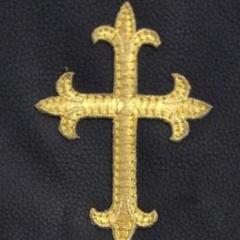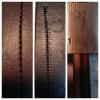-
Posts
95 -
Joined
Content Type
Profiles
Forums
Events
Blogs
Gallery
Everything posted by JRodz
-
Sinpac, I have 2 and I use BK blades in other knives as well, they are the first knives I reach for.
-

Wallet Folding Problems
JRodz replied to Highlands858's topic in Purses, Wallets, Belts and Miscellaneous Pocket Items
Highlands,I think it might be a market/customer issue. Comparing a tooled or carved veg tan back plus a couple layers of thin veg tan leather to a commercial wallet made with garment leather is comparing apples to oranges. For one, the back of most commercial wallets is as thick as your lining leather and the lining leather in those wallets is probably only about 1 oz. if not less (paper thin). Your wallets may be just fine after they break in. As an extreme example, I make biker wallets with a 5/6 oz. back, 2 gussetts of 3/4 oz., and a full length pocket on top with an ID window. Needless to say, it is a brick but after oiling and breaking in the guys love them. For my bi-folds and tri-fold, I use 3/4, 4/5, or 5/6 back and 1/2, 2/3, or 3/4 on the insides. Roper wallets are made with the same thicknesses as the tri-folds and bi-folds. However, my stuff goes to guys who ride, drive, or build for a living and who like things as rugged and tough as their lives. I can't see the guy with the designer clothes and fancy sportscar buying one of those wallets. For that guy I would use different leather and a different style wallet. Best of luck. -
Bob Kovar on this site or Pilgrim Shoe Machine Co. most likely have any part you may need.
-
Paul,I have a 111W156 and I had similar problems with my machine. It was sewing at about 20 stitches per inch, almost like an embroidery mchine. In my case, the stitch adjustment just wasn't taking. The fix in my case was to clean everything, lube it up, and walk through the adjustment process again. On adjusting the stitch setting after that it slid in and I felt it catch as I was turning the handwheel. As I remember, there was a detail I had missed the first time around, like the position of something else. I've had no issues since.I'm no expert, so hopefully one of the experts chimes in.Best of luck,
-
I would leave th top as is and just loosen the bobbin tension and start from there.
-
It should not be hard to pull thread from the bobbin, you should feel a light drag but it should pull out smooth and easy. Generally speaking, the bobbin tension isn't adjusted very often, balancing is done with the top tension.
-
Wolf, Was sewing some business card holders and wallet interiors tonight and thought about your question on capacity. Again, I'm not sure of all the differences between the 111w156 and the 111w155 other than the reverse but I grabbed a couple scraps of strap leather and sewed them together. I didn't take the time to change or readjust the machine so this is sewn at 9 spi with 92 thread and a 21 needle. The brown is the top side, the black is the bobbin side, and the other is to show the thickness of the two. I did not make a stitch groove or anything just ran it through. This is about maxed out though, because it is leaving marks on bottom but it was still feeding smoothly without help.
-

Help With Tippman Boss When Back-Stitching
JRodz replied to RDark's topic in Leather Sewing Machines
Robert,There is another post titled "Tippman Boss" with some discussion on the same topic. I posted some links to other posts discussing what to do at the start and end of a stitch line. That being said, it includes some of the same info from the same people. It helped me so hopefully it will help you too. -
Ironpounder, Here are some of the posts I was referring to. Hope they help. http://leatherworker.net/forum/index.php?showtopic=34997&st=0&p=216930&hl=backstitching&fromsearch=1entry216930 http://leatherworker.net/forum/index.php?showtopic=38875&st=0&p=241408&hl=backstitching&fromsearch=1entry241408 http://leatherworker.net/forum/index.php?showtopic=38875&st=0&p=241408&hl=backstitching&fromsearch=1entry241408 http://leatherworker.net/forum/index.php?showtopic=7006&st=0
-
Ironpounder,Depending on what I'm sewing, sometimes I just leave extra thread at the start and finish to tie it off by hand just like I would if I was stitching by hand. If it is a bigger item, then I will finish it off by getting both threads on the back side, form a square knot and work it into the needle hole, cut the thread close, and melt edges. I use a microtorch, in part because I had some at work, but also because the tip is very precise and I melt the edges without burning anything else. There are some old posts on this site describing the process in more detail, this site is where I learned that trick/tip.
-
Wolf, I have a 11W156 and I frequently sew veg tan liners (3 to 4 oz.) onto 1/4" thick bridle or latigo belt blanks. The machine handles it no problem using 138 thread with a 23 needle. 8 to 12 oz should be no problem. I changed to smooth presser feet and no issues with marking. I got the machine dirt cheap from a friend, but I have been told by the mechanic that has been servicing it that it has a value of $600 easy. He personally has offered me $450 for it knowing he can get more. Good luck,
-
In my limited experience, the tension issue is not specific to the Boss, I have a Singer 111W156 and a Singer 29K62 too and they all require some adjusting depending on the leather thickness, type of leather, and needle and thread combination. They all have their quirks, just a matter of getting to know what combinations work. The more you use it, the easier it will get. Again, for me the issue with the Boss is that I haven't spent much time on it until recently even though I've had it for about 3 years.As far as thread goes, I've been using prelubed bonded nylon or bonded polyester which haved frayed, broken, or unraveled so I don't think that is it. I also use leather point needles and change them often, so I don't think that is it either. I really just attribute it to the type, thickness, and temper of the leather. BTW, I am usually only making adjustments to the top tension unless I change the bottom thread. From what I've read on this forum that seems to be normal and expected. Unfortunately, it gives us rookies a good amount of frustration.My advise, just use your Boss and sew all the scraps you can in various types, thicknesses, and tempers and with experience in making those adjustments you'll be good to go. There was a post on here a while back where one gentlemen made himself a cheet sheet counting the threads on the tension adjustment screws for different setups so he could easily and quickly change set ups. I think he had even made reference marks with a sharpie to help himself out.Happy stitching and enjoy your new toy,
-
Ironpounder,X2 to what Husker and OldTimer said. My Boss always requires a stretch and warm up on a sample piece and does not like to be rushed. If I oil, sew a sample, make adjustments, sew a sample, then take it nice and easy things usually work out really good. If I try to rush it and get going to quick or push/pull the piece, then things go south really quick. All in all it is a great machine and does it's job. That being said, I don't use it all that often and it is set up with 277 and a 25 needle and I don't do thread changes very often. Not to mention that most of what I do sew on it is of relatively the same thickness and temper. Usually heavy duty belts, motorcycle luggage straps, and other strap items. My guess is the more variety you sew and different thread/needle combinations you use, the more time you"ll spend on adjustments and samples. Just my $.02, BTW, if I was any more of a rookie I'd be in the stands. But Ive learned a lot by reading this forum and trial and error.
-

Looking For A Good Servo Motor For Singer 111W155
JRodz replied to Iron Pounder's topic in Leather Sewing Machines
Got mine along with a speed reducer from Cobra Steve. Was easy to install and runs great. Big benefit was being able go to Steve's shop and see how they were set up and having the phone support. Haven't done business with Bob but hear nothing but good thing, so I don't think you could go wrong with him either. -

Patcher Will Not Advance The Material - Help?
JRodz replied to CustomDoug's topic in Leather Sewing Machines
-

Patcher Will Not Advance The Material - Help?
JRodz replied to CustomDoug's topic in Leather Sewing Machines
Doug, You are looking at the wrong place. Take the needle to the highest point, loosen the butterfly, and you will see it will move one way or another (toward you for higher, away for lower), there is a low, medium, and high.On the metal surface right behind the butterfly you should see the lertter "L, M, and H" or maybe some hash lines. On these old machines the markings may be faint or covered with paint. In any case, you do not have to do anything with the items you put arrows too. PM me with your email and I will send you the manual, if you don't already have one. I would post it here but the file is too large. regard, -

Patcher Will Not Advance The Material - Help?
JRodz replied to CustomDoug's topic in Leather Sewing Machines
Doug, I'm not an expert but recently went through my patcher, read lots of posts, and the user manual about a million times. But in your picture, the butterfly nut on the backside looks like it is set to medium, if you loosen the nut and push it back all the way it will lift the foot higher. Although, on the medium setting you should have adequate clearance for two layers or 3 oz. and the manual says you should set to just over the thickness of what you are sewing and no more than is necessary. As far as the stitch length, my machine had not been used in 15+ years so it was sewing poorly and the movement was not smooth or consistent and it missed stiches. I took it apart cleaned and polished all the pieces, put it back together, gave it a good lube, and now it sews beautifully. Before I worked on it I had ordered all the tension parts and the presser foot spring just in case but didn't need any of them. It was a win win because now I have a rebuild kit just in case. My buddy Brian (sewing machine dealer and mechanic) says the majority of issues he services are either tension or minor adjustments. So I would play with tension as Wiz recommended, a couple weeks ago I was switching out from 46 to 69 thread and noticed that adjusting the tension affects the presser foot spring tension and vice versa. They share the plate that they push off of. Good luck, -
Thanks for the responses gentlemen. @Ferg, not so much that it is cast iron, as that there isn't much room on those stands. @Bob, That is pretty much how I'm doing it now, I have a small worktable next to it and have been setting the spools down on it. I just have limited space and am hoping to consolidate as much as possible. I did see a coat rack in the garage that is tall and skinny and is on wheels, I might have to modify that into a stand. Thanks again,
-
Hello everyone, I need to add a thread stand to hold 1/2 lb and full lb spools to my machine. It has the original cast iron stand so drilling through it is not an option. Hoping there is an easy way to adapt or clamp something on.For those of you that have these types of machines how did you mount the stand?What type of stand did you use?How is it working out for you? Any help or guidance you can provide would be greatly appreciated. Thank you!
-
Contact Pilgrim shoe and sewing machine company, they have all parts in stock. Great prices, excellent service, and quick.
-
I have one of these machine that I use to sew fabrics, they are great with up to 4 - 6 layers of denim or twill. With regard to leather, a friend of mine is a Janome dealer, and his advice to me was not to attempt any more than 2 - 3 oz. of soft/garment leather with a leather point needle. Thread will also be an issue since he didn't recommend any heavier than 69.
-

Switched Out Clutch Motor For Servo - Not Really Happy.
JRodz replied to JimC's topic in Sewing Leather
I have a servo I purchased from Steve @ Cobra on my Singer 111W and it gives me gradual control. Like Ferg, I can go from barely press the pedal and have a cup of Joe between stitches to about 30 stitches per minute at full pedal ( I have mine adjusted down considerably). It isn't pulley to pulley though, I do have a speed reducer (also from Steve) between the motor and machine. I have not had any issues with power to punch through the leather but I haven't gone any thicker than about 18 oz total. I am usually sewing medium to firm temper veg tan but have sewn 5 or 6 layers of upholstery leather. I do most of my sewing with a 21 or 22 needle and 138 bonded polyester thread. -
Hello all, Please excuse my ignorance but I'd like some info on the awls in the attached pictures. They are not sharp, so I am assuming they are used for stitching (like a lacing fid) or for opening up holes versus punching holes. These are very old and I have done a search on the two brands and can't find any information on them. They are stamped with the name "King" and "Maeder" and might have come from Europe. There are also some older ones stamped "CFI" and " NEA & %%%." The gentleman that owned them was a shoe maker from Poland and the tools range from 20 years old to tools he brought with him when he emmigrated 60+ years ago. I would also like to get a haft for them but the ends are much bigger than any I've seen. If any of you have any ideas on a haft, please share. Otherwise, I might have to fabricate one myself. Thanks in advance for your feedback.
-
Thanks Wiz.






